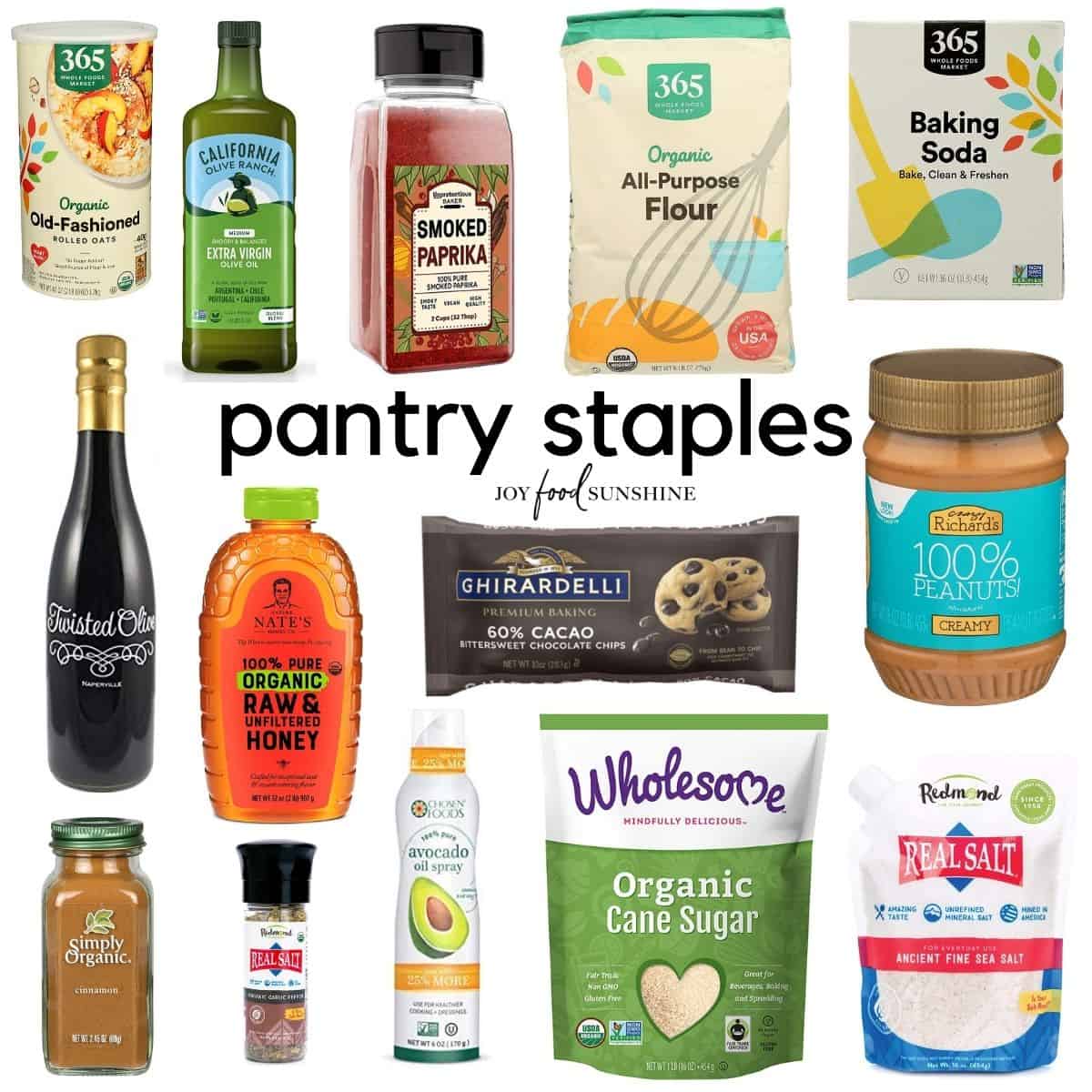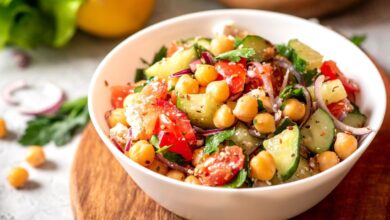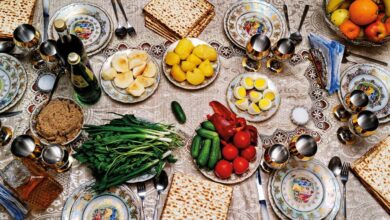
Chef Hacks to Get the Most From Your Pantry Staples
Chef Hacks to Get the Most From Your Pantry Staples: Tired of the same old meals? Unlocking the full potential of your pantry staples can transform your cooking and create delicious, diverse dishes. This guide will empower you to elevate everyday ingredients into culinary masterpieces.
From mastering the art of flavor combinations to exploring unconventional staples, we’ll delve into chef-approved techniques that will revolutionize your culinary journey.
Imagine turning simple onions, garlic, and tomatoes into flavor bombs, or elevating a humble grain into a hearty and satisfying meal. With a few strategic tricks and a sprinkle of creativity, your pantry can become a culinary playground, brimming with possibilities.
Get ready to discover the hidden treasures within your pantry and transform your cooking from ordinary to extraordinary.
The Power of Spices

Spices are the unsung heroes of the culinary world, capable of transforming simple ingredients into flavor-packed masterpieces. They add depth, complexity, and a touch of magic to our dishes, elevating them from ordinary to extraordinary. A well-stocked spice rack is an essential tool for any home cook, offering a universe of flavor possibilities.
Common Pantry Spices and Their Culinary Applications
Spices are a diverse group, each with its own unique flavor profile and culinary applications. Here are some common pantry spices and their uses:
- Black Pepper:A staple in most kitchens, black pepper adds a pungent, slightly spicy kick to dishes. It’s versatile and can be used in both sweet and savory dishes.
- Cinnamon:Warm and aromatic, cinnamon is often used in desserts and baked goods. It also pairs well with savory dishes like chicken and lamb.
- Garlic Powder:A convenient way to add garlic flavor without chopping, garlic powder is a must-have for savory dishes like pasta sauces and soups.
- Ginger:With its warm, earthy flavor, ginger is a versatile spice that can be used in both sweet and savory dishes. It’s commonly used in Asian cuisine, but it also works well in baked goods and drinks.
- Oregano:A staple in Italian cuisine, oregano adds a slightly bitter, earthy flavor to dishes like pasta sauces and pizzas.
- Paprika:This spice comes in various colors, each with a slightly different flavor profile. Sweet paprika is often used in Hungarian dishes, while smoked paprika adds a smoky depth to dishes like chili.
- Rosemary:With its strong, piney flavor, rosemary is often used in Mediterranean cuisine. It pairs well with lamb, chicken, and roasted vegetables.
- Turmeric:This spice is known for its vibrant yellow color and earthy, slightly bitter flavor. It’s often used in Indian cuisine and has anti-inflammatory properties.
Spice Combinations for Different Cuisines and Flavor Profiles
The beauty of spices lies in their ability to be combined to create unique flavor profiles. Here’s a table showcasing some spice combinations for different cuisines and flavor profiles:
| Cuisine | Flavor Profile | Spice Combination |
|---|---|---|
| Indian | Warm, Aromatic | Cumin, coriander, turmeric, ginger, garlic powder, chili powder |
| Mexican | Spicy, Smoky | Chili powder, cumin, oregano, paprika, garlic powder |
| Italian | Herbaceous, Earthy | Oregano, basil, thyme, garlic powder, black pepper |
| Mediterranean | Bright, Citrusy | Rosemary, thyme, oregano, lemon zest, garlic powder |
| Asian | Sweet, Savory, Spicy | Ginger, garlic powder, chili powder, soy sauce, sesame oil |
Maximizing Grains and Legumes
Grains and legumes are nutritional powerhouses that deserve a prominent spot in your pantry. These humble ingredients are incredibly versatile, affordable, and packed with essential nutrients that can fuel your body and enhance your culinary creations.
Nutritional Benefits of Grains and Legumes
Grains and legumes are excellent sources of complex carbohydrates, fiber, protein, and essential vitamins and minerals. Their nutritional profile makes them a valuable addition to a balanced diet.
- Rice: A good source of carbohydrates, providing energy and supporting brain function. Brown rice, in particular, is rich in fiber, which aids digestion and promotes satiety.
- Beans: A powerhouse of protein, fiber, and iron. They are also a good source of folate, potassium, and magnesium, which contribute to heart health and bone strength.
- Lentils: High in protein and fiber, lentils are a great source of iron, folate, and potassium. They are also low in fat and cholesterol, making them a heart-healthy choice.
Cooking Methods for Grains and Legumes
Mastering the art of cooking grains and legumes is essential for achieving optimal texture and flavor.
| Ingredient | Cooking Method | Tips for Optimal Texture and Flavor |
|---|---|---|
| Rice | Boiling | Use a ratio of 1:2 (rice to water) and simmer until the water is absorbed. Rinse the rice before cooking for fluffier results. |
| Pressure Cooking | Reduces cooking time significantly. Use a 1:1 ratio (rice to water) and cook until the pressure is released naturally. | |
| Beans | Boiling | Soak beans overnight for faster cooking and to reduce gas-producing compounds. Simmer until tender, about 1-2 hours. |
| Pressure Cooking | Shortens cooking time significantly. Use a 1:1 ratio (beans to water) and cook until the pressure is released naturally. | |
| Lentils | Boiling | No need to soak lentils. Simmer until tender, about 20-30 minutes. |
| Pressure Cooking | Cook lentils quickly, about 10-15 minutes. |
Hearty and Flavorful Recipes
Grains and legumes form the foundation for countless delicious and nourishing meals.
Rice-Based Recipes
- Chicken and Rice Soup: A classic comfort food that’s both satisfying and easy to make. Use chicken broth, diced chicken, vegetables, and your favorite spices to create a flavorful soup. Serve with a dollop of yogurt or sour cream.
- Fried Rice: A versatile dish that can be adapted to your taste. Combine cooked rice with your favorite vegetables, protein (such as tofu, chicken, or shrimp), and seasonings.
- Rice Pudding: A creamy and comforting dessert. Combine cooked rice with milk, sugar, spices, and vanilla extract. Cook until thickened and serve warm or chilled.
Bean-Based Recipes
- Black Bean Burgers: A healthy and flavorful alternative to traditional beef burgers. Combine black beans, oats, spices, and vegetables to create patties. Grill, bake, or pan-fry until cooked through.
- Chili: A hearty and comforting stew. Combine beans, ground meat, tomatoes, onions, and your favorite spices. Simmer until thickened and serve with cornbread or rice.
- Bean Salad: A refreshing and nutritious side dish. Combine cooked beans with chopped vegetables, herbs, and a vinaigrette dressing.
Lentil-Based Recipes
- Lentil Soup: A hearty and flavorful soup. Combine lentils, vegetables, broth, and spices. Simmer until the lentils are tender.
- Lentil Loaf: A meatless alternative to traditional meatloaf. Combine lentils, vegetables, breadcrumbs, and spices. Bake until cooked through and serve with gravy.
- Lentil Curry: A flavorful and aromatic dish. Combine lentils, coconut milk, vegetables, and spices. Simmer until the lentils are tender and serve with rice or naan bread.
Beyond the Basics: Chef Hacks To Get The Most From Your Pantry Staples
Stepping beyond the familiar realm of pantry staples can unlock a world of flavor and culinary creativity. While staples like rice, pasta, and canned beans are reliable workhorses, venturing into less-common ingredients can add depth, complexity, and a touch of the unexpected to your dishes.
Exploring Unconventional Pantry Staples
These lesser-known ingredients offer a wealth of culinary possibilities, waiting to be discovered:
- Dried Mushrooms:These concentrated bursts of umami can transform soups, stews, and sauces. Rehydrated in hot water, they become a flavorful base for broths or can be finely chopped and incorporated into sauces and stuffings.
- Capers:These briny, tangy buds add a burst of Mediterranean flavor to pasta dishes, sauces, and even salads. They complement rich flavors like fish, lamb, and chicken.
- Anchovy Paste:A powerful umami bomb, anchovy paste can be used sparingly to add depth to sauces, dips, and even marinades. It pairs well with tomato-based dishes and adds a savory complexity to soups and stews.
- Nutritional Yeast:A deactivated yeast with a cheesy flavor, nutritional yeast is a vegan source of B vitamins and protein. It can be sprinkled on popcorn, pasta, or added to smoothies for a cheesy kick.
- Pickled Ginger:Often found alongside sushi, pickled ginger offers a refreshing contrast to rich or spicy dishes. It can be used to brighten up salads, stir-fries, or even added to cocktails.
- Sumac:A tangy, lemony spice derived from berries, sumac adds a bright and citrusy flavor to dishes. It’s a staple in Middle Eastern cuisine and can be used to sprinkle on salads, grilled meats, or roasted vegetables.
Unique Recipes Featuring Unconventional Staples
Here are some unique recipes that showcase the versatility of these ingredients:
Dried Mushroom Risotto
This recipe uses dried porcini mushrooms to create a deeply flavorful risotto:
Ingredients:
One of my favorite chef hacks is to always have a can of chickpeas in my pantry – they’re a versatile protein source that can be used in so many ways! From hearty salads to creamy dips, you can find delicious ways to use chickpeas under 360 calories , making them a great option for healthy and budget-friendly meals.
And don’t forget about using chickpeas in soups and stews – they add a satisfying texture and boost the nutritional value of any dish!
Sometimes, cooking feels like a marathon, requiring you to strategize and use every resource wisely. Just like planning your route for everything you need to know about ultra walking , you need to know your pantry staples and how to make them work for you.
A little creativity can turn simple ingredients into delicious meals, and just like ultra-walking, it’s all about endurance and resourcefulness!
- 1 cup dried porcini mushrooms
- 4 cups hot water
- 1 tablespoon olive oil
- 1 onion, chopped
- 2 cloves garlic, minced
- 1 cup Arborio rice
- 1 cup dry white wine
- 4 cups chicken broth
- 1/2 cup grated Parmesan cheese
- Salt and pepper to taste
Instructions:
From turning stale bread into croutons to whipping up a flavorful broth from vegetable scraps, there are endless ways to maximize your pantry staples. And when it comes to vegetables, don’t limit yourself to just the usual suspects! Check out 5 ways to up your vegetable game for some inspiration to expand your veggie repertoire.
Once you’ve got those fresh ingredients on hand, you can explore new flavor combinations and turn your pantry staples into delicious meals.
- Rehydrate the dried mushrooms in hot water for 30 minutes. Strain the liquid, reserving both the mushrooms and the liquid.
- Heat the olive oil in a large saucepan over medium heat. Add the onion and cook until softened, about 5 minutes.
- Add the garlic and cook for 1 minute more.
- Stir in the rice and cook for 1 minute, stirring constantly.
- Add the white wine and cook until absorbed.
- Gradually add the chicken broth, 1 cup at a time, stirring constantly until each addition is absorbed before adding the next.
- Add the reserved mushroom liquid and the chopped mushrooms.
- Continue cooking until the rice is al dente, about 18 minutes.
- Stir in the Parmesan cheese and season with salt and pepper to taste.
- Serve immediately.
Capers and Anchovy Pasta
This simple pasta dish is bursting with Mediterranean flavors:
Ingredients:
- 1 pound pasta (such as spaghetti or linguine)
- 2 tablespoons olive oil
- 2 cloves garlic, minced
- 1/4 cup capers, rinsed
- 1 tablespoon anchovy paste
- 1/4 cup chopped fresh parsley
- Salt and pepper to taste
Instructions:
- Cook the pasta according to package directions.
- While the pasta is cooking, heat the olive oil in a large skillet over medium heat. Add the garlic and cook until fragrant, about 1 minute.
- Stir in the capers and anchovy paste and cook for 1 minute more.
- Add the cooked pasta to the skillet and toss to coat.
- Stir in the parsley and season with salt and pepper to taste.
- Serve immediately.
Nutritional Yeast and Roasted Vegetable Salad
This salad uses nutritional yeast to add a cheesy flavor to roasted vegetables:
Ingredients:
- 1 pound mixed vegetables (such as broccoli, carrots, Brussels sprouts, and sweet potatoes)
- 2 tablespoons olive oil
- 1/2 teaspoon salt
- 1/4 teaspoon black pepper
- 1/4 cup nutritional yeast
- 1/4 cup chopped fresh herbs (such as parsley, dill, or chives)
Instructions:
- Preheat oven to 400 degrees F (200 degrees C).
- Toss the vegetables with olive oil, salt, and pepper.
- Spread the vegetables in a single layer on a baking sheet.
- Roast for 20-25 minutes, or until tender and slightly browned.
- Toss the roasted vegetables with nutritional yeast and herbs.
- Serve warm or cold.
Nutritional Benefits and Storage Tips
- Dried Mushrooms:A good source of fiber, B vitamins, and antioxidants. Store in an airtight container in a cool, dry place for up to 6 months.
- Capers:Low in calories and a good source of iron. Store in the refrigerator in the brine they come in for up to 6 months.
- Anchovy Paste:Rich in protein, calcium, and vitamin D. Store in the refrigerator for up to 6 months.
- Nutritional Yeast:A good source of B vitamins, protein, and trace minerals. Store in an airtight container in a cool, dry place for up to 6 months.
- Pickled Ginger:A good source of vitamin C and antioxidants. Store in the refrigerator in the brine they come in for up to 6 months.
- Sumac:A good source of antioxidants. Store in an airtight container in a cool, dry place for up to 1 year.
Smart Storage and Organization
A well-organized pantry is a chef’s best friend, ensuring easy access to ingredients, preventing waste, and streamlining meal preparation. By implementing smart storage strategies, you can transform your pantry into a culinary haven.
Utilizing Containers and Labels
Clear, airtight containers are essential for maintaining the freshness and quality of pantry staples. They prevent moisture, pests, and odors from affecting your ingredients.
- Storing Dry Goods:Utilize airtight containers for storing grains, flours, sugars, and other dry ingredients. Clear containers allow you to easily see what you have and when it needs replenishing.
- Storing Snacks and Treats:Separate snacks and treats into airtight containers to prevent them from becoming stale or absorbing flavors from other ingredients.
- Labeling for Clarity:Label all containers with the contents and the date of purchase. This helps with inventory management and ensures you use older items first.
Maximizing Shelf Space
Maximize your pantry’s vertical space by using tiered shelves, pull-out drawers, and stacking bins.
- Tiered Shelves:Utilize tiered shelves to create additional storage space and make it easier to access items at different heights.
- Pull-Out Drawers:Pull-out drawers allow for easy access to items stored at the back of the pantry.
- Stacking Bins:Stacking bins can be used to organize similar items, such as canned goods or baking supplies.
Preventing Food Waste, Chef hacks to get the most from your pantry staples
Food waste is a significant issue, and proper pantry organization can play a crucial role in reducing it.
- First In, First Out (FIFO):Always use older items first. Rotate your stock regularly, placing newer items behind older ones.
- Storage Guidelines:Follow recommended storage guidelines for different ingredients to maximize their shelf life. For example, store potatoes in a cool, dark place, and keep onions and garlic separate to prevent them from spoiling quickly.
- Portioning and Freezing:If you have large quantities of ingredients, portion them into freezer-safe containers for future use. This prevents waste and allows you to use only what you need.
Final Review
By embracing these chef hacks, you’ll not only unlock a world of culinary possibilities but also elevate your cooking to new heights. You’ll be surprised at how simple ingredients can transform into flavor-packed masterpieces, and you’ll be empowered to create delicious meals that impress your family and friends.
So, let’s unleash the potential of your pantry and embark on a culinary adventure together!






